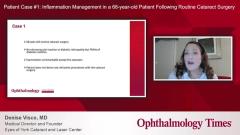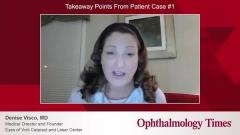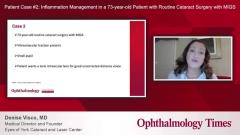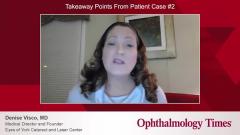
Takeaway points from patient case #2
Denise Visco, MD, MBA, discusses takeaway points from patient case #2 for post-operative inflammation management for routine cataract surgery.
Denise Visco, MD, MBA: When we look again at the PREMED [PREvention of Macular EDema after cataract surgery] study [NCT01774474], we can see that patients were prospectively randomized to 1 of 3 groups. The first was topical nonsteroidals. The second was topical steroids, and the third was combination. This particular study had approximately 300 patients in each group. The study found that the incidence of cystoid macular edema and postoperative inflammation was lowest in the combined topical group. It is of note that none of these patients had intracameral medications such as phenylephrine-ketorolac or intracameral steroids. This was purely the topical group regimen, and our group was pro topical in this particular patient, as I said, beginning several days preoperatively. We did know that the incidence of cystoid macular edema in the PREMED study was particularly high, and this study looked at macular thickness on OCT [optical coherence tomography]. We believe that likely is one reason that the incidence was as skewed a bit high for that study. However, the differences of the combined regimen vs the singular topical regimen was statistically significant.
In looking at intracameral options for pain in inflammation, we find another study that showed the combined topical nonsteroidal and steroid combination was inferior in controlling pain inflammation and cystoid macular edema to a combination of topical nonsteroidals and intracameral phenylephrine-ketorolac. The combination of the nonsteroidal intracamerally with topical beginning preoperatively and for 10 weeks postoperatively drove that cystoid macular edema rate down to 0.5% or less. And a third study looking at [using] the nonsteroidal topically for 4 weeks instead of 10 weeks shows that the rate of cystoid macular edema does remain at 0.5% or less. When we try to avoid using the topical nonsteroidal after cataract surgery, the cystoid macular edema rate increases, and our group feels that this particular topical drop is important in controlling pain and inflammation with or without topical steroids.
Ultimately, our group decided that the best regimen for this patient was to begin topical nonsteroidals and steroids 3 days preoperatively, have intracameral phenylephrine-ketorolac with their surgery, and then continue the topical steroids for 4 weeks postoperatively, tapering from 4 times to 3 times, 2 times, then 1 time over 4 weeks, and the nonsteroidal unanimously was felt to be continued for 8 weeks in a patient with such high risk as the one in our case. The bottom line with managing pain and inflammation with cataract surgery is that we don’t have a good solution to get rid of our topical medications at this point in time. Many of us don’t feel comfortable dropping the topical steroid, despite the fact that when we incorporate topical nonsteroidals with intracameral phenylephrine-ketorolac, we have the lowest rate of cystoid macular edema, pain, and inflammation after cataract surgery. Belt and suspenders seems to rule. What’s important is that we’re delivering a great result for our patient and also a wonderful experience with their cataract surgery. Thank you for watching this Ophthalmology Times® presentation. We hope you found this presentation informative and applicable to your practice.
TRANSCRIPT EDITED FOR CLARITY
Newsletter
Don’t miss out—get Ophthalmology Times updates on the latest clinical advancements and expert interviews, straight to your inbox.

















































